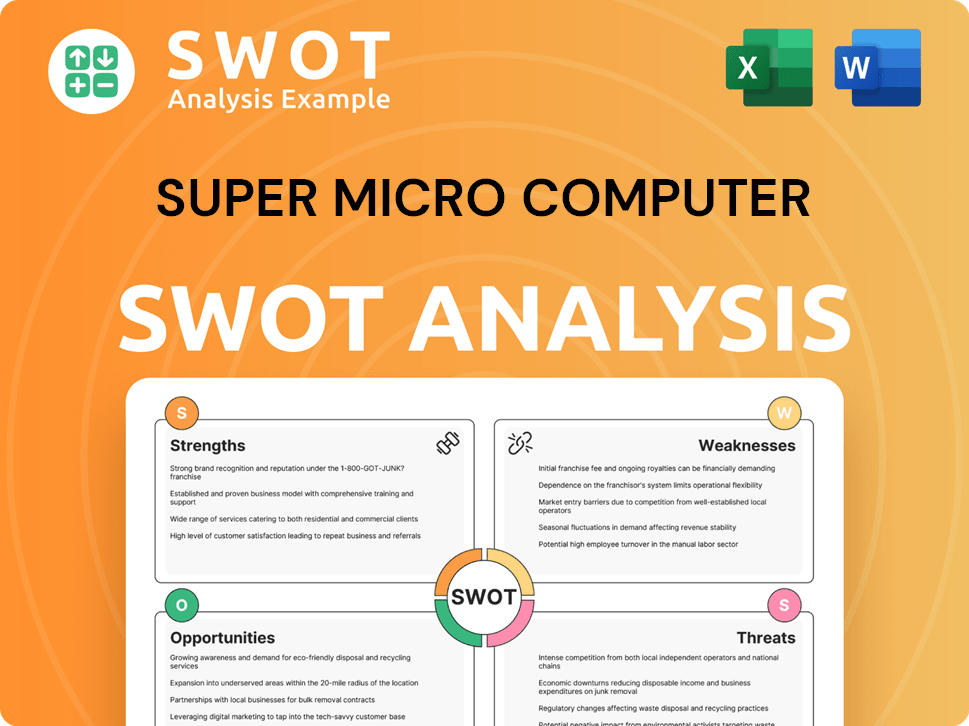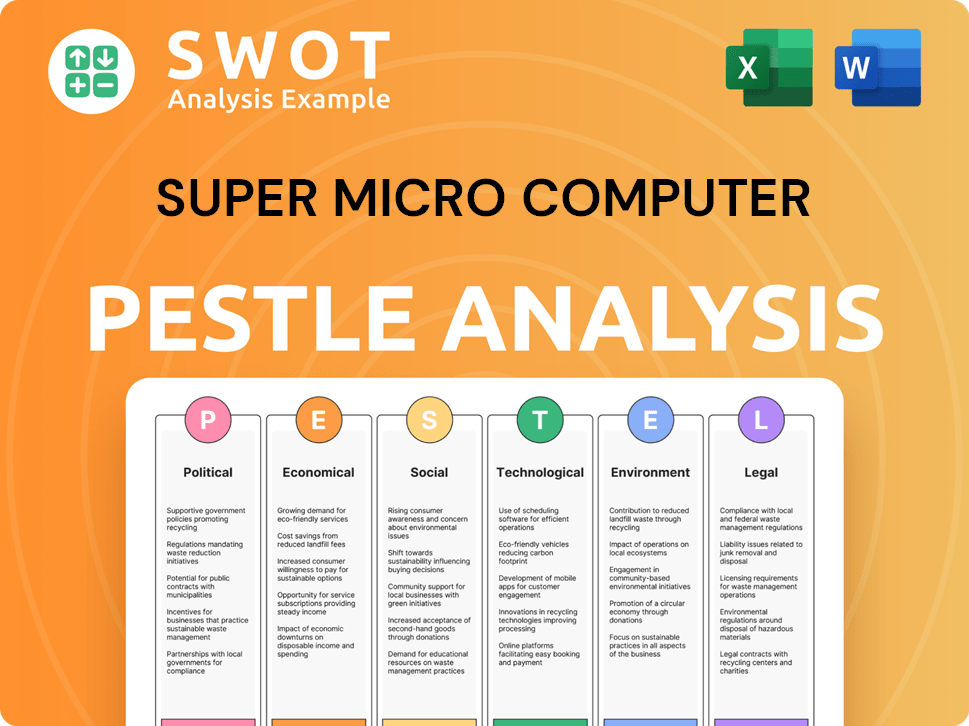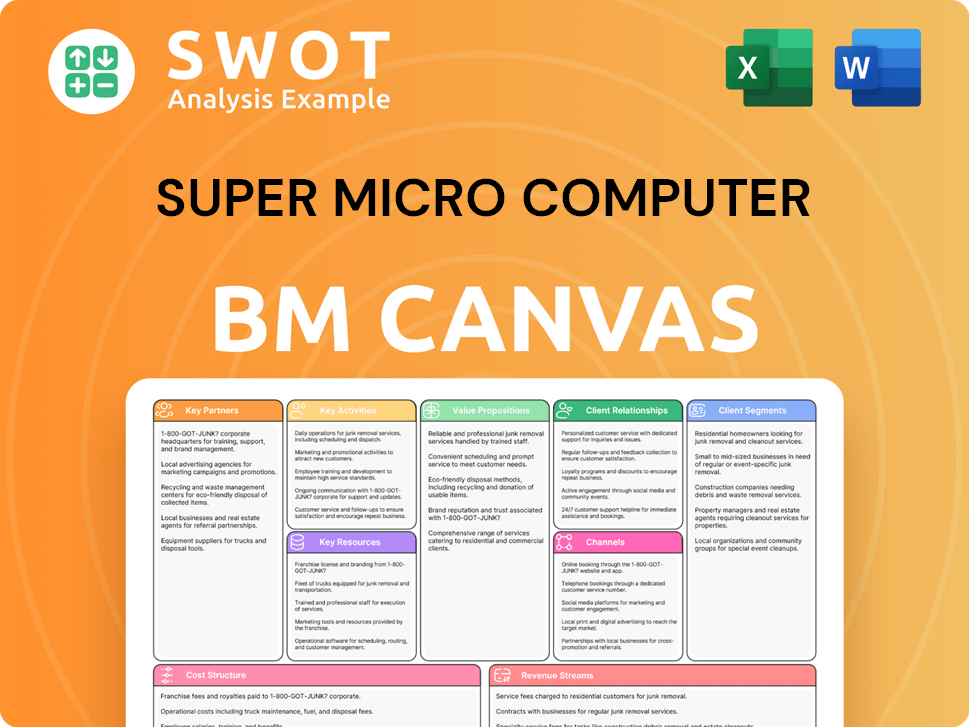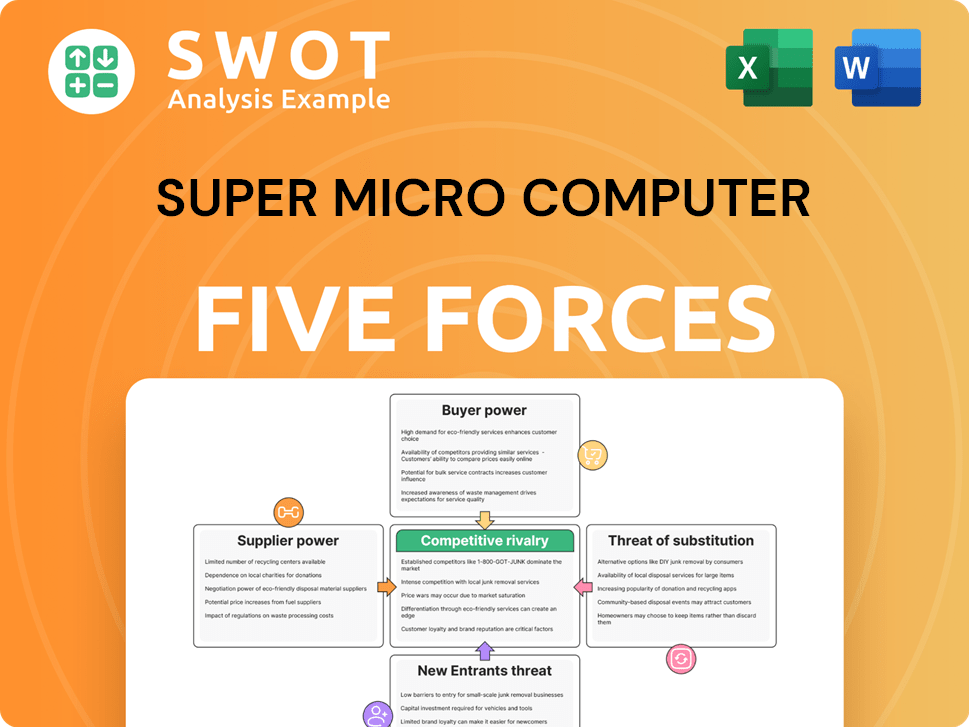Super Micro Computer Bundle
Can Super Micro Computer Maintain Its Edge in the AI Era?
Super Micro Computer (SMCI) has become a dominant force in the high-performance computing world. Founded in 1993, the company's journey from motherboard designs to comprehensive server solutions showcases its adaptability. Today, Supermicro is a key player, supplying essential infrastructure to the world's leading enterprises.

This Super Micro Computer SWOT Analysis will provide a detailed market analysis of Supermicro's position in the server market. We'll examine the competitive landscape, identifying key industry competitors and evaluating Supermicro's strengths and weaknesses. Understanding Supermicro's competitive advantages and its growth strategy is crucial for any investor or strategist navigating the dynamic world of high-performance computing.
Where Does Super Micro Computer’ Stand in the Current Market?
Supermicro holds a significant and growing position in the server and storage market, particularly benefiting from the rising demand for AI infrastructure. The company's strong financial performance, including a record $3.66 billion in revenue for the second quarter of fiscal year 2024 (ended December 31, 2023), which is a 103% increase year-over-year, highlights its robust growth. This expansion underscores its increasing scale compared to industry averages, especially as it capitalizes on the AI boom.
Supermicro's core offerings include servers, storage systems, motherboards, chassis, and related components, all based on an x86 architecture. These products serve various customer segments, such as data centers, cloud computing providers, enterprise IT, and specialized AI and machine learning applications. Geographically, Supermicro has a global presence, catering to customers across North America, Europe, and Asia. The company has strategically shifted its focus to become a preferred provider for complex, high-density computing solutions, moving beyond components to offer complete rack-scale AI and liquid-cooled solutions.
This strategic shift has allowed Supermicro to capture a premium market segment driven by the intensive demands of AI workloads. The company's financial health, demonstrated by its significant revenue growth and profitability, positions it as a formidable player in the industry. For more insights into the company's ownership and financial structure, you can explore Owners & Shareholders of Super Micro Computer.
While exact market share figures fluctuate, Supermicro has a notable presence in the high-performance computing (HPC) and AI server segments. The company's revenue growth, with a 103% increase year-over-year in Q2 fiscal year 2024, indicates strong market penetration and expansion.
Supermicro offers a broad range of server and storage solutions, including servers, storage systems, motherboards, and chassis. The company is increasingly focused on providing complete rack-scale AI and liquid-cooled solutions, catering to the growing demand for high-performance computing.
Supermicro serves diverse customer segments, including data centers, cloud computing providers, enterprise IT, and specialized AI and machine learning applications. This diversification allows the company to mitigate risks and capitalize on various market opportunities.
Supermicro has a global presence, serving customers across North America, Europe, and Asia. This wide geographic reach enables the company to tap into different markets and customer bases, supporting its growth strategy.
Supermicro's key strengths include its strong financial performance, diverse product offerings, and focus on high-growth segments like AI. However, the company faces challenges such as intense competition and the need to continuously innovate.
- Strengths: Strong revenue growth, focus on AI, diverse product portfolio.
- Weaknesses: Intense competition, reliance on x86 architecture.
- Opportunities: Expansion in AI and HPC markets, strategic partnerships.
- Threats: Economic downturns, supply chain disruptions, and competitors.
Super Micro Computer SWOT Analysis
- Complete SWOT Breakdown
- Fully Customizable
- Editable in Excel & Word
- Professional Formatting
- Investor-Ready Format

Who Are the Main Competitors Challenging Super Micro Computer?
The competitive landscape for Supermicro is intense, encompassing both established tech giants and specialized hardware providers. This dynamic environment requires continuous adaptation and innovation to maintain market share and drive growth. Understanding the key players and their strategies is crucial for assessing Supermicro's position and future prospects within the server market.
Supermicro faces a multifaceted competitive environment, with rivals ranging from large, diversified technology companies to specialized original design manufacturers (ODMs). The server market is characterized by rapid technological advancements, evolving customer demands, and intense price competition. This necessitates a deep understanding of the competitive dynamics to navigate the challenges and capitalize on opportunities.
Direct competitors include Dell Technologies, Hewlett Packard Enterprise (HPE), and Lenovo. These companies offer comprehensive server solutions and compete with Supermicro across various market segments. They leverage extensive global networks and established customer relationships.
Indirect competition comes from ODMs like Quanta Computer, Inventec, and Wistron, who primarily serve hyperscale data centers. Nvidia, a key partner, can also be an indirect competitor in specific areas. These companies influence the broader server market.
Strategic alliances and partnerships between chipmakers and server manufacturers shape the market. The demand for AI infrastructure has intensified competition, particularly for critical components and skilled talent. These factors influence the competitive dynamics.
Dell Technologies is a major competitor, offering a wide range of server, storage, and networking solutions. Dell's global presence and extensive service network enable it to compete effectively across various enterprise segments. The company's strong brand recognition and established customer base are significant advantages.
HPE is a key competitor, particularly in the enterprise server and hybrid cloud solutions market. HPE often competes on integrated solutions and its long-standing customer relationships. HPE's focus on innovation and its comprehensive product portfolio are key competitive strengths.
Lenovo has a strong presence in the x86 server market, especially in Asia. Lenovo competes on price-performance and a broad range of offerings. The company's ability to offer competitive pricing and a diverse product lineup makes it a formidable competitor.
The competitive landscape is further shaped by the rise of AI and the demand for specialized hardware. Companies like Nvidia, while partners, also compete by expanding their ecosystem. The strategic alliances between chipmakers (Intel, AMD, Nvidia) and server manufacturers can shift market dynamics. To delve deeper into the business model and revenue streams, consider exploring the Revenue Streams & Business Model of Super Micro Computer article.
Several factors influence the competitive dynamics in the server market, including product innovation, pricing strategies, and supply chain management. Supermicro's ability to adapt to these factors will be crucial for maintaining its market position.
- Product Innovation: Continuous development of new server technologies and features.
- Pricing: Competitive pricing strategies to attract customers.
- Supply Chain: Efficient supply chain management to ensure product availability.
- Customer Relationships: Building and maintaining strong customer relationships.
- Market Trends: Adapting to emerging trends such as AI and cloud computing.
Super Micro Computer PESTLE Analysis
- Covers All 6 PESTLE Categories
- No Research Needed – Save Hours of Work
- Built by Experts, Trusted by Consultants
- Instant Download, Ready to Use
- 100% Editable, Fully Customizable

What Gives Super Micro Computer a Competitive Edge Over Its Rivals?
The competitive landscape for Super Micro Computer (Supermicro) is shaped by its unique strengths in the server market. Supermicro's 'Building Block' architecture and rapid time-to-market are key differentiators. The company's focus on high-performance, customizable solutions positions it well against competitors in the data center, cloud, and AI segments. This focus has allowed them to gain a significant market share.
Supermicro's ability to quickly integrate the latest technologies, such as new CPU and GPU architectures, provides a significant time-to-market advantage. This agility is crucial in a fast-evolving market. Supermicro has cultivated strong partnerships with leading chip manufacturers, including Intel, AMD, and Nvidia, which is a key differentiator.
Supermicro's strategic partnerships, particularly with Nvidia, are crucial. These collaborations enable the delivery of high-performance, liquid-cooled AI solutions. Supermicro's focus on energy efficiency also appeals to environmentally conscious customers. The company's growth strategy is closely tied to these partnerships and its ability to innovate, as discussed in Growth Strategy of Super Micro Computer.
Supermicro's modular design allows for highly customizable and optimized server and storage solutions. This flexibility enables customers to configure systems precisely to their needs, especially for specialized workloads like AI and HPC. This contrasts with more standardized offerings from some larger competitors. This approach allows Supermicro to offer tailored solutions.
Supermicro is often among the first to offer solutions incorporating cutting-edge components, such as new CPU and GPU architectures. This speed is a significant advantage in the server market. The company's ability to quickly adapt to new technologies helps it stay ahead of the competition. This agility is key in the fast-paced tech industry.
Supermicro has cultivated strong partnerships with leading chip manufacturers, including Intel, AMD, and Nvidia. Close collaboration with Nvidia, especially in the development of AI-optimized servers, has been a key differentiator. These partnerships enable Supermicro to deliver cutting-edge solutions. These relationships are crucial for innovation.
Supermicro's focus on energy efficiency resonates with environmentally conscious customers and those seeking to reduce operational costs. Energy-efficient designs are increasingly important in the data center and cloud segments. This focus helps Supermicro attract customers looking to minimize expenses. This is a growing trend in the industry.
Supermicro's competitive advantages include its unique 'Building Block' architecture, rapid time-to-market, and strong relationships within the AI ecosystem. These strengths have allowed Supermicro to capture a significant portion of the server market. The company's focus on innovation and strategic partnerships contributes to its sustained success.
- Customization: Offers highly customizable server solutions.
- Speed: Quickly integrates the latest technologies.
- Partnerships: Strong collaborations with leading chip manufacturers, including Nvidia.
- Efficiency: Focus on energy-efficient designs.
- Market Position: Built a loyal customer base in data center, cloud, and AI segments.
Super Micro Computer Business Model Canvas
- Complete 9-Block Business Model Canvas
- Effortlessly Communicate Your Business Strategy
- Investor-Ready BMC Format
- 100% Editable and Customizable
- Clear and Structured Layout

What Industry Trends Are Reshaping Super Micro Computer’s Competitive Landscape?
The server and storage industry is experiencing significant shifts, primarily driven by the rapid expansion of artificial intelligence (AI), the increasing adoption of liquid cooling technologies, and the continued growth of cloud computing. These trends create both opportunities and challenges for companies like Super Micro Computer (Supermicro). Understanding the Brief History of Super Micro Computer is crucial to grasping its current position and future prospects within this dynamic market.
Supermicro's competitive landscape is evolving, influenced by technological advancements and market dynamics. The company faces pressures from competitors and must adapt to maintain its market share and capitalize on emerging opportunities. This chapter explores the industry trends, future challenges, and opportunities shaping Supermicro's trajectory.
The server market is being significantly reshaped by AI, liquid cooling, and cloud computing. The demand for AI-optimized infrastructure, driven by large language models and generative AI, presents a major opportunity for Supermicro. The shift towards liquid cooling for efficient heat dissipation in powerful AI systems is another key trend.
Intense competition for critical components, like high-end GPUs and CPUs, can impact supply chains. The rapid pace of technological change requires continuous investment in research and development. Geopolitical tensions and trade policies could also introduce supply chain disruptions or market access restrictions.
Significant growth opportunities lie in expanding its footprint in emerging AI markets. Developing more specialized solutions for niche AI applications and strengthening partnerships with AI ecosystem leaders are also key. Edge computing and decentralized processing are emerging trends that could create new market segments.
The server market is highly competitive, with companies like Dell Technologies and Hewlett Packard Enterprise (HPE) as key rivals. Supermicro's ability to innovate in areas like liquid cooling and AI-optimized servers will be critical for maintaining and growing its market share. The global server market was valued at approximately $107.5 billion in 2023.
Supermicro's competitive advantages include its focus on high-performance, high-density server solutions and its ability to quickly adapt to new technologies. The company's financial performance reflects its strong position, with revenue growth in recent years. For instance, Supermicro's revenue for fiscal year 2023 reached $7.1 billion, a significant increase from the previous year.
- Key Strengths: Innovation in AI and liquid cooling, strong partnerships, and agile manufacturing.
- Market Challenges: Intense competition from established players and hyperscale cloud providers.
- Growth Strategy: Expanding AI solutions, strengthening strategic partnerships, and focusing on emerging markets.
- Future Outlook: Continued specialization in AI and liquid cooling, requiring ongoing innovation and adaptation.
Super Micro Computer Porter's Five Forces Analysis
- Covers All 5 Competitive Forces in Detail
- Structured for Consultants, Students, and Founders
- 100% Editable in Microsoft Word & Excel
- Instant Digital Download – Use Immediately
- Compatible with Mac & PC – Fully Unlocked

Related Blogs
- What are Mission Vision & Core Values of Super Micro Computer Company?
- What is Growth Strategy and Future Prospects of Super Micro Computer Company?
- How Does Super Micro Computer Company Work?
- What is Sales and Marketing Strategy of Super Micro Computer Company?
- What is Brief History of Super Micro Computer Company?
- Who Owns Super Micro Computer Company?
- What is Customer Demographics and Target Market of Super Micro Computer Company?
Disclaimer
All information, articles, and product details provided on this website are for general informational and educational purposes only. We do not claim any ownership over, nor do we intend to infringe upon, any trademarks, copyrights, logos, brand names, or other intellectual property mentioned or depicted on this site. Such intellectual property remains the property of its respective owners, and any references here are made solely for identification or informational purposes, without implying any affiliation, endorsement, or partnership.
We make no representations or warranties, express or implied, regarding the accuracy, completeness, or suitability of any content or products presented. Nothing on this website should be construed as legal, tax, investment, financial, medical, or other professional advice. In addition, no part of this site—including articles or product references—constitutes a solicitation, recommendation, endorsement, advertisement, or offer to buy or sell any securities, franchises, or other financial instruments, particularly in jurisdictions where such activity would be unlawful.
All content is of a general nature and may not address the specific circumstances of any individual or entity. It is not a substitute for professional advice or services. Any actions you take based on the information provided here are strictly at your own risk. You accept full responsibility for any decisions or outcomes arising from your use of this website and agree to release us from any liability in connection with your use of, or reliance upon, the content or products found herein.